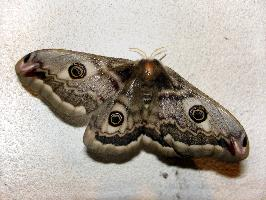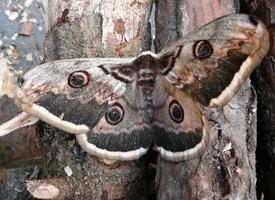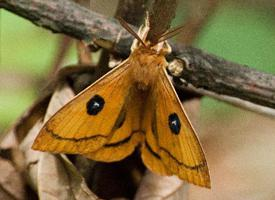
Poids et mesures
| Longueur | de 55 à 80 mm |
|---|
Description de l'animal
The Small Emperor Moth (Saturnia pavonia), a captivating species within the Saturniidae family, is a marvel of the natural world, renowned for its striking appearance and fascinating life cycle. This species, which is the smallest of the European saturniids, exhibits a remarkable sexual dimorphism, meaning that the males and females are distinctly different in their physical appearance, particularly in terms of size, color, and antennae structure.Adult males of the Small Emperor Moth boast a wingspan of approximately 45-60 mm. They are particularly noted for their vibrant coloration; the wings are a rich blend of brown and orange hues, with a distinctive eye-spot on each wing. These eye-spots are not merely decorative; they play a crucial role in predator deterrence, mimicking the eyes of larger creatures to ward off potential threats. The males are also equipped with large, feather-like antennae, which are highly sensitive to the pheromones released by females, aiding them in their nocturnal quests to locate potential mates over considerable distances.
Females, on the other hand, are significantly larger, with a wingspan that can reach up to 80 mm. Their wings are more subdued in color, featuring shades of grey and brown, which serves as excellent camouflage against predators when they are at rest during the day. Unlike the males, the females have smaller, less elaborate antennae since they do not need to detect pheromones in the air.
The life cycle of the Small Emperor Moth is as fascinating as its appearance. The females lay their eggs on the underside of leaves of a wide variety of host plants, including heather and bramble, in the late spring. These eggs hatch into caterpillars that are equally striking; they are covered in black, white, and yellow spiky hairs, which provide them with a degree of protection from predators. The caterpillars are voracious eaters, feeding on the leaves of their host plants until they are ready to pupate. Pupation takes place in a cocoon spun close to the ground, where the caterpillar transforms into the adult moth, emerging the following spring to continue the cycle.
The Small Emperor Moth is distributed widely across Europe and parts of Asia, inhabiting a range of habitats from heathlands and moorlands to gardens and open woodland. Despite its widespread presence, this species, like many others, faces threats from habitat destruction and the use of pesticides, which can impact its populations.
In summary, the Small Emperor Moth is a fascinating and beautiful species, with a complex life cycle and intriguing behaviors. Its striking appearance, marked by the vivid colors and patterns of the males and the more subdued tones of the females, along with its remarkable adaptation for survival, makes it a subject of interest not only for lepidopterists but for anyone with an appreciation for the natural world's wonders.
Animaux similaires
Nouvelles photos d'animaux
Top 10 des animaux
- Dolphin gull (Leucophaeus scoresbii)
- Diana monkey (Cercopithecus diana)
- Moustached guenon (Cercopithecus cephus)
- Galápagos tortoise (Geochelone nigra complex)
- Japanese macaque (Macaca fuscata)
- Russian tortoise (Testudo horsfieldii)
- Stone loach (Barbatula barbatula)
- Greek tortoise (Testudo graeca)
- Common flying dragon (Draco volans)
- Vendace (Coregonus albula)

